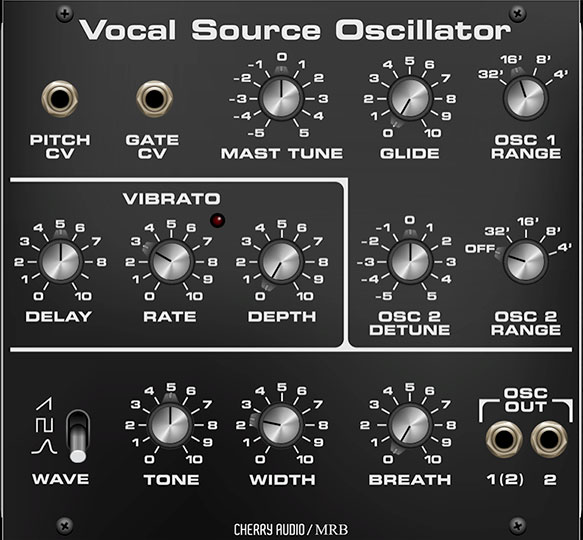
The Vocal Source Oscillator is a special dual-oscillator module optimized for use with the Rackmode Vocoder module, but it can independently be used as a standard 1V/oct audio oscillator. What separates it from standard analog-style synth oscillators is its unique "glottal" waveform, which includes specialized parameters that enable it to reproduce both tonal and "air" sounds of the human vocal tract.
Inputs, Outputs, and Controls
Pitch CV- Accepts a CV input for pitch. Typically this would come from the Pitch jack in the IO Panel CV Out section, or from a sequencer CV out.
Gate CV- Patch gate voltages here to enable oscillator output. Unlike typical VCO modules, Vocal Source Oscillator includes a gate input that needs to connected, or it won't product any output.
Master Tune- Sets overall pitch up or down five semitones. This affects both Osc 1 and Osc 2.
Osc 1 Range- Sets oscillators 1's overall coarse pitch range in standard organ footage settings of 32', 16', 8', and 4'.
Osc 2 Detune- Sets Osc 2's pitch up or down five semitones.
Osc 2 Range- Sets oscillators 2's overall coarse pitch range in standard organ footage settings of 32', 16', 8', and 4'. The Off position disables oscillator 2 (hence the clever name).
Vibrato / Delay- Delays the onset of vibrato from 0.1 up to 5 seconds.
Vibrato / Rate- Sets the vibrato modulation rate from 2 to 18 Hz. The flashing LED indicates the current rate.
Vibrato / Depth- Sets the vibrato depth from 0 to 100% (about a whole-step).
Wave- Selects ramp, variable-width pulse, or Rackmode Vocoder's exclusive glottal wave. The glottal wave selection engages a vocal cord wave model widely used in speech synthesizers. Each cycle of the wave is divided into two sections in time referred to as the "open" and "closed" phases. When air passes the vocal cords which have been brought together to produce voiced speech or song, the cords open and close once each pitch cycle admitting a single puff of air, similar to a trumpeter's lips.
Tone- Emphasizes bass or treble frequencies, center setting is neutral. The Tone knob affects all three waveforms.
Width- When the pulse wave is selected, this affects the pulse width, with maximum width (square) at the center setting.
When the glottal wave is selected, Width adjusts the relative time between open and closed phases, similar to the duty-cycle of the pulse wave. During the open phase, air passes through the opening between the vocal cords, so at higher settings, you'll hear a lot of "air." When the Width is at maximum, the vocal cords are open for almost all of each cycle and lots of air is used. Narrow widths (i.e. lower Width settings) are associated with holding the vocal cords in a tense manner, thus the open phase is short and you don't hear much air.
Try this yourself - speak with your throat very open and relaxed and you'll find that you will use up your air supply very quickly. When creating high voices, especially with the Formant control turned to the right, you will find that using a wide Width and some Breath dialed to taste will create a very realistic sounding voice.
If the ramp wave is selected, the Width knob is disabled and grays out .
Breath- Sets the volume of the "air" heard at higher Width settings. When the ramp or pulse wave are selected, the Breath knob is disabled.
Osc Out jacks- Separate outputs for each of the two oscillators. This is intended for use with Rackmode Vocoders stereo carrier inputs and Formant section. If the 2 output jack is unused, both oscillators are summed to the 1(2) output jack.